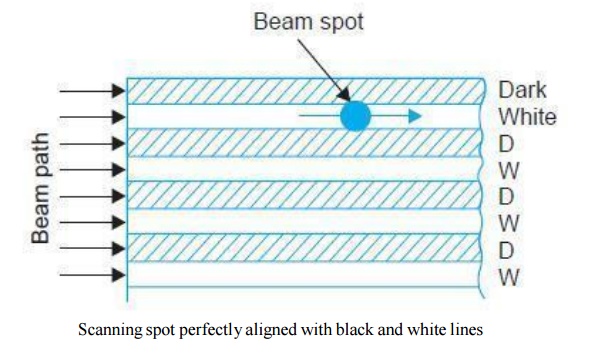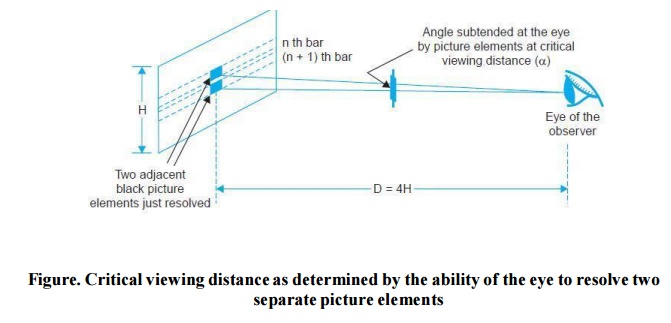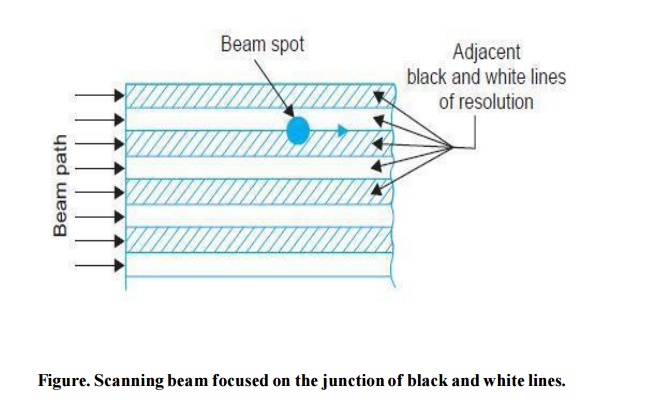Chapter: Television and Video Engineering : Fundamentals of Television
Number of Scanning Lines
NUMBER OF SCANNING LINES
Most
scenes have brightness gradations in the vertical direction. The ability of the
scanning beam to allow reproduction of electrical signals according to these
variations and the capability of the human eye to resolve these distinctly,
while viewing the reproduced picture, depends on the total number of lines
employed for scanning.
It is
possible to arrive at some estimates of the number of lines necessary by
considering the bar pattern shown in Fig. (a), where alternate lines are black
and white. If the thickness of the scanning beam is equal to the width of each
white and black bar, and the number of scanning lines is chosen equal to the
number of bars, the electrical information corresponding to the brightness of
each bar will be correctly reproduced during the scanning process.
Obviously
the greater the number of lines into which the picture is divided in the
vertical plane, the better will be the resolution.However, the total number of
lines that need be employed is limited by the resolving capability of the human
eye at the minimum viewing distance.
The
maximum number of alternate light and dark elements (lines) which can be
resolved by the eye is given by 1N v = αρ where N v = total number of lines
(elements) to be resolved in the vertical direction, α = minimum resolving
angle of the eye expressed in radians, and ρ = D/H = viewing-distance/picture
height.
For the
eye this resolution is determined by the structure of the retina, and the
brightness
level of
the picture. it has been determined experimently that with reasonable
brightness variations and a minimum viewing distance of four times the picture
height (D/H = 4), the angle that any two adjacent elements must subtend at the
eye for distinct resolution is approximately one minute (1/60 degree). This is
illustrated in Fig (b). Substituting these values of α and ρ we get 1 ≈ 860 ( π
/ 180 × 1 / 60 ) × 4
Thus if
the total number of scanning lines is chosen close to 860 and the scanning beam
as illustrated in Fig. (a) just passes over each bar (line) separately while
scanning all the lines from top to bottom of the picture frame, a distinct pick
up of the picture information results and this is the best that can be expected
from the system.
This
perhaps explains the use of 819 lines in the original French TV system. In
practice however, the picture elements are not arranged as equally spaced
segments but have random distribution of black, grey and white depending on the
nature of the picture details or the scene under consideration.
Statistical
analysis and subjective tests carried out to determine the average number of
effective lines suggest that about 70 per cent of the total lines or segments
get separatel y scanned in the vertical direction and the remaining 30 per cent
get merged with other elements due to the beam spot falling equally on two
consecutive lines.
This is illustrated in Fig.(c). Thus the
effective number of lines distinctly resolved, i.e., N r = N v × k, where k is
the resolution factor whose value lies between 0.65 to 0.75. Assuming the value
of k = 0.7 we get, N r = N v × k = 860 × 0.7 = 602.

However,
there are other factors which also influence the choice of total number of
lines in a TV system.
Tests
conducted with many observers have shown that though the eye can detect the
effective sharpness provided by about 800 scanning lines, but the improvement
is not very significant with line numbers greater than 500 while viewing
pictures having motion. Also the channel bandwidth increases with increase in
number of lines and this not only adds to the cost of the system but also
reduces the number of television channels that can be provided in a given VHF
or UHF transmission band.
Thus as a
compromise between quality and cost, the total number of lines inclusive of
those lost during vertical retrace has been chosen to be 625 in the 625-B
monochrome TV system. In the 525 line American system, the total number of
lines has been fixed at 525 because of a somewhat higher scanning rate employed
in this system.


Related Topics